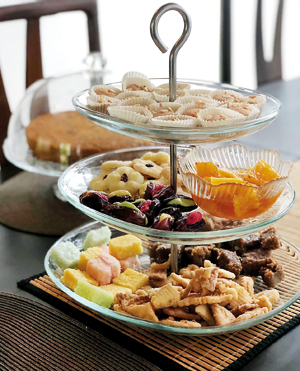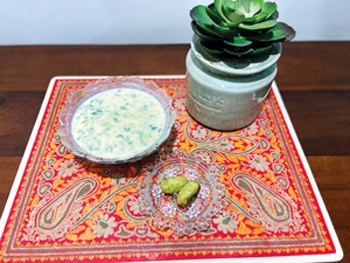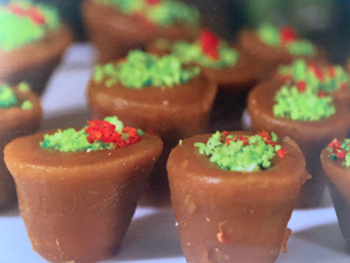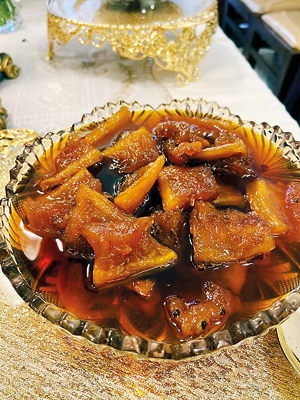Sweet connection for Eid

Eid platter (top to bottom): Bol, nanakatha, stuffed dates and dosi, dodol, silverai and pol toffee
One of the most awaited holidays in the Islamic calender is ‘Eid-ul-Fitr’ known as the festival of breaking the fast. With happy greetings of ‘Eid Mubarak’ and exchanging salaams, Muslims around the world celebrate the end of the holy month of Ramadan in which they fast from sunrise till sunset as an act of worship, a chance to get closer to God, and learn lessons of compassion and kindness.
The Muslim community in Sri Lanka is multi-ethnic, comprising mostly of Moors, Malays, Bohras and Memons. Stemming from various cultural backgrounds their festivities on this special day vary but one tradition remains common: the ‘Eid sweets table’ present in every household to share with family and guests.
The largest of the Muslim communities in Sri Lanka, the Moors are of diverse origin mainly descended from Arab traders with a smaller group from the Indian state of Tamil Nadu.
Although now many people buy readymade sweets for their table, Faranaz Reza remembers the sweets on the Eid table that her grandmother and mother would tirelessly prepare despite the effort each dish required. Watalappan – the jaggery and coconut milk pudding was a firm favourite while Showarshee Dodol – sago muscat was commonly made in a vivid green.
Sanja made of agar agar giving it a softer jelly-like consistency was made in the egg shells that were discarded from the eggs used to make the Watalappan. “Back then, there weren’t any fancy moulds as such so they would fill egg shells with the sanja,” Faranaz shares.

Kheer Khurma and Kharak
Palaharam – a fried dough coated in sugar (the present day sweet murukku)is cut out in different shapes with a star and crescent shape being an absolute must. Paniyaram is a kavum similar to the athirasa. Other dishes that would grace a Moor Eid table would be seenimah, dosi, ada as well as the simple butter cake. Kalu dodol was also a famous dish and Faranaz relates how the consistency and sweetness of the dodol changed according to the locality. In her husband’s hometown in the upcountry the dodol was very soft, unlike the harder dodol she was used to.
Dodol is also a favourite in the Malay community. “ Dodol making was a very labour-intensive process where I remember my nene (grandmother) stirring for hours the mixture of jaggery, coconut milk and rice flour. Halfway through the mix would become like a custard and my siblings and I would wait impatiently till we got a little bit of the hot, gooey goodness,” says Farah Majid reminiscing about her childhood Eid memories.

Cheena kueh
Originating from Malaysia and Indonesia, the Malays share very similar dishes with the Moors sometimes known by different names in Malay. The ‘Serikaya’which is the watalappan, Silverai known as palaharam, ada or ada bole, sanja, dodol and more.
“Most people are unaware of this but the Serikaya originated from the Malays. However while we eat it as a dessert made out of jaggery, eggs, coconut milk, ground spices and cashew nuts, the Indonesians and Malaysians use it a jam and spread it on bread, biscuits, etc,” Farah shares.
Dosi is made out of seasonal fruits cooked in sugar syrup and cinnamon, cardamom and rose essence and pineapple, mango and ambarella work best for the sticky, sweet dish. Ada Bole is a cake made out of rice flour spiced with cinnamon, cardamom, nutmeg and other spices while Cheena kueh is sort of a glutinous yet hard custard made out of jaggery, rice flour and coconut milk served with grated coconut. They are usually made in ceramic receptacles.
“ When my sisters moved abroad, my mother wanted to make sure they stayed connected to their roots and observe tradition so she made them a Malay recipe cookbook which was later published,” Farah tells us proudly adding that the revised edition of ‘Resipi Makanan Melayu’ is available with the Sri Lanka Malay Association.
The Memons are a small minority in the Muslim community who came from the Sindh region in Pakistan while some hailing from the Kathiawar region in modern-day Gujarat, India have their food influenced by those flavours.
Saarah Omar walks us through the Memon sweets that usually grace her table at Eid. “Kheer Khuma is a sweet milk that has layers of different flavours. It’s infused with saffron, cardamom, pistachio and almonds and topped up with fried vermicelli. We usually serve this in a soup bowl at lukewarm temperature first thing in the morning,” she tells us.

Pineapple dosi
Dul dul quite similar to sanja is a light and cooling dish made with agar agar and milk. Maamoul is a stuffed biscuit sometimes dusted with icing sugar- crunchy on the outside with a gooey nut or date mixture filling. Then there’s the Anday ka mesub which are sweet egg slices that have an almost flaky biscuit texture with a sweet and nutty taste.
“Usually there is a cake served as well on the table and the flavour depends on the family favourite. My family gets either a chocolate or ribbon cake which we typically buy from our favourite bakers,” Saarah says.
“ A traditional Bohra dish for Eid-ul-Fitr, the Sheer Khurma is made of milk, vermicelli, nuts and there is a special way to prepare it. It is served for breakfast on Eid,” says Fehmida Jafferjee whose family tree begins in Pakistan.
The Bohra community has strong roots in the west Indian state of Gujarat and many of them speak a Gujarati dialect.
The Kharak dish consists of deseeded dates that have been boiled in milk till dry and stuffed with ‘maava’, a hardened milk paste that has been condensed combined with sugar and pistachios or other nuts. These are common staples adorning a Bohra Eid table.
Other sweets are Kheer- similar to Sheer Khurma but made of rice instead of vermicelli. The dry fruit halwa is usually made of figs, dates, pistachios, almonds, cashewnuts and walnuts with the ingredients ground together, then mixed with milk and ghee before being sauteed in a pan.
Fehmida takes orders for both sweet and savoury dishes influenced by the flavours of Pakistan. You can reach her at 0773104642 for
any inquiries.



